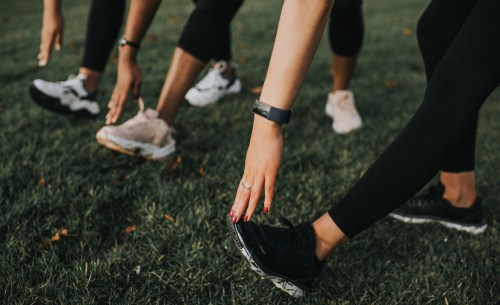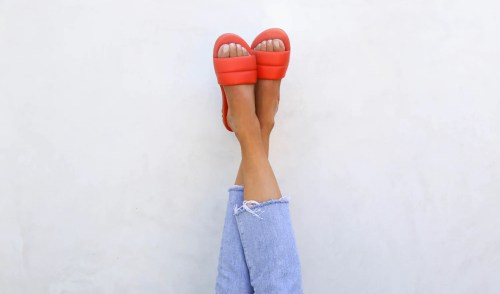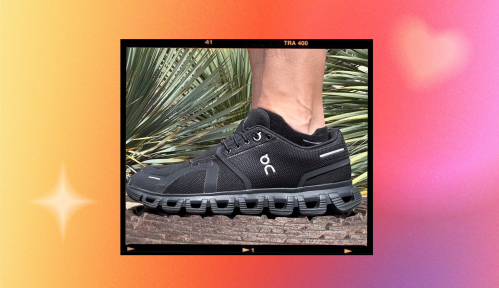Our editors independently select these products. Making a purchase through our links may earn Well+Good a commission
Achilles tendonitis is about as comfortable as running into an ex in a shoe store. Marked by deep pain along the back of the heel, this condition happens when the Achilles tendon (which connects your calf muscles to your heel bone) becomes swollen and inflamed, says podiatrist Brad Schaeffer, DPM, foot surgeon at Central Park SOLE and star of TLC’s “My Feet Are Killing Me.” “It’s most common in runners who very suddenly increase the intensity or duration of their runs,” he says.
Experts in This Article
board-certified foot surgeon at Sole Podiatry NYC and star of TLC’s My Feet Are Killing Me
board-certified podiatry specialist at Ankle &
podiatrist and reconstructive foot surgeon based in New York City
If you’re feeling this pain, know that you’re not alone: Achilles tendonitis affects a whopping 10 percent of runners each year. Luckily, with proper footwear and a sound training plan, it’s both preventable and treatable.
What causes Achilles tendonitis?
At its most distilled, Achilles tendonitis is essentially an overuse injury. The tendon gets inflamed when the band repeatedly endures strain, says Dr. Schaeffer. The fact is, the Achilles tendon gets used anytime you walk, jump, run, or, you know, use your feet and legs to move about the world. The impact placed on the tendon, however, is greatest when running (which is why runners are especially prone to Achilles tendonitis).
But much as the connective tissues in the body can be trained and strengthened through progressive overload, so can the Achilles tendon. Most often, the Achilles gets inflamed when someone runs faster or longer than their previous training can support, says Dr. Schaeffer. Hill running, running on hard or uneven surfaces, and wearing poorly-designed running shoes can also increase the risk of Achilles tendonitis, per research.
You can prevent Achilles tendonitis by training intentionally
The best way to prevent Achilles tendonitis is by training with longevity in mind. To tweak the now-trite idiom, that means running as if you’re training for a marathon (life!) rather than a 5K (the immediate future). A run coach can help you devise a running plan that takes your current fitness level, age, goals, and Achilles health in mind.
If a run coach isn’t within your budget, or you want to take a stab at programming for yourself, keep the 10 percent rule in mind. “During your runs, you want to build your mileage slowly,” Cameron Yuen, DPT, a doctor of physical therapy at Bespoke Treatments in New York City previously told Well+Good. A good rule of thumb is to aim to increase your mileage by no more than 10 percent week over week, he says. If you’re currently running 10 miles per week, for instance, next week try logging 11. More than that and you risk overuse injuries.
Your footwear can help you prevent (and recover from) Achilles tendonitis, too
The shoes you wear while exercising can truly make a difference, and help you avoid Achilles tendonitis, says Dr. Schaeffer. Broadly speaking, “you want a shoe that provides a good balance of cushioning, arch support, and heel support to help reduce tension in the Achilles tendon,” he says.
Here are seven shoes podiatrists recommend for Achilles tendonitis.

Asics Gel Nimbus 25 — $160.00
Hey runners, this one’s for you. “With its excellent cushion system and great medial support, the Asics Gel Nimbus provides runners with Achilles stress much-needed reprieve while they stride,” says Dan Geller, DPM, a sports podiatrist with Kane Footwear. The 8 millimeter heel-to-toe drop also works to keep stress off the tender tendon, he adds. A bonus? The shoe doesn’t prioritize cushion over fashion: All 13 colorways are cute AF.

Mizuno Wave Creation 20 — $170.00
Taking lightweight to the next level, this true-to-size sneak has a carved out sole that increases bounce while decreasing heft. “This light and fast shoe provides the perfect amount of cushion on the heel to ease Achilles pain,” says Dr. Geller. “The light, breathable material is also a bonus.”
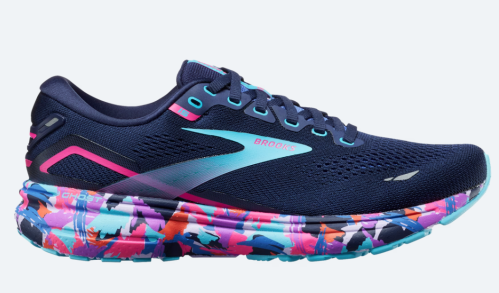
Brooks Ghost 15 — $140.00
The Brooks Ghost 15 aren’t just tried-and-true, celeb-approved (hey, Jennifer Garner!) sneaks—they’re also Achilles tendon–friendly. “They have a stable midsole, wide toe box, and 12 millimeter heel-to-toe drop that work together to alleviate stress and strain on the Achilles tendon,” says Mohammad Rimawi, DMP, board certified podiatrist with Manhattan Foot Specialists in New York City. “It’s a great shoe for everyday training as well as everyday life,” he says. And with 27 color options, you’re bound to find one or five that fit your fashion needs, too.

Hoka Bondi 8 — $165.00
If you’re a runner you’ve probably heard that with each stride, it’s best to strike the ground with your midsole, then roll forward towards your toes. Well, “the structure of this sneaker is that of a rocker-type shoe” which encourages that exact motion, says Dr. Rimawi. “This allows the foot to move more freely through its progression, which minimizes the load placed on the Achilles tendon, as well as the calf in general.” Better form and reduced risk of Achilles tendonitis? Talk about a win-win.
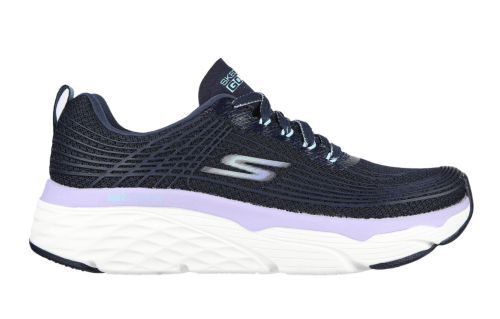
Skechers Women's Max Cushioning Elite Sneaker — $105.00
Ever since the big chunky shoe came back into fashion, so too have Sketchers sneakers. Thankfully, with models like the Max Cushioning Elite Sneaker, it’s a fad folks prone to Achilles tendonitis—as well as those on a budget—can happily partake in. “This is an ideal option for someone with Achilles tendonitis because it has a cushioned midsole and soft textile upper to help provide comfort and support,” says Gregory Alvarez, DPM, FACFAS, podiatrist at the Ankle & Foot Centers of America. “It also has a padded heel collar and integrated toe guard, which create additional protection for your Achilles when you’re on the move.”
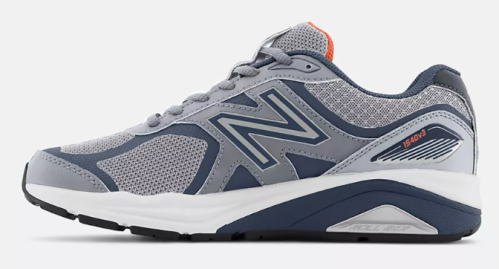
New Balance 1540V3 Running Shoe — $179.00
This sneak comes in two colors: gray and… a slightly darker gray. But what it lacks in color it makes up for in comfort. “It provides amazing cushioning in the heel, as well as superior stability, thanks to its high-tech midsole,” says Dr. Alvarez. “Additionally, this shoe has a breathable mesh upper, making it comfortable and lightweight even during warm months,” he says.
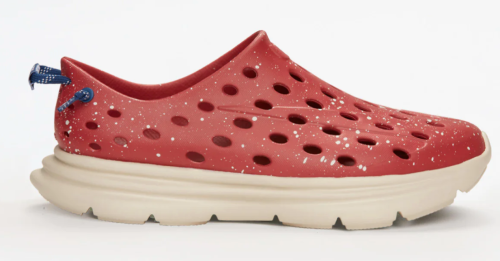
Kane Revive — $75.00
Okay, okay, this may not be a sneaker, but it’s a damn good adventure shoe for anyone with Achilles pain, according to Dr. Geller. Made from a fancy-schmancy material dubbed RestoreFoam™, the Kane Revive is breathable, quick-drying, and sport-friendly. “The proprietary blend [of materials] offer both structure and support, and provide an excellent cushion,” he says. “The 10 millimeter heel-to-toe offset is the perfect position for the foot to ease tension off the Achilles.”
Other (low-cost) ways to treat and prevent Achilles tendonitis
Don’t want to drop dough on another pair of sneakers? You can also customize your current footwear to become more Achilles-friendly.
A heel lift is a shoe insert that goes under your heel to provide, as the name suggests, a lil lift. Commonly used to offset the negative effects of tight calf muscles, Achilles tendons, or ankles, Dr. Schaeffer says that a small heel lift can help decrease the tension on the delicate tendon. “Typically, a five millimeter heel lift is adequate for easing tension,” says Dr. Geller.
Another option is to add in an insole, which is a shoe insert that supports your entire foot. “The right insole can transform what sneaker you already have into one that has impact-absorbing cushioning, a shock absorbing heel, and flexible arch support,” says Dr. Schaeffer. Dr. Scholl’s Prevent Pain Protective Insole and SuperFeet Adapt Run Insoles are both good options.
Sign up for the Well+Good SHOP Newsletter
Get exclusive deals on wellness, beauty, fitness, and food products that have been hand-picked by our editors.
Got it, you've been added to our email list.


